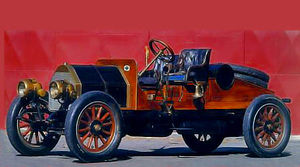SCAT
Societa Ceirano Automobili Torino
SCAT (Societa Ceirano Automobili Torino) was formed by Giovanni Ceirano at Turin in July 1906, leaving his previous company Junior (Junior Fabbrica Torinese Automobili) behind . The company started big, with 150 workers and producing over 100 cars per year. Expansion followed, and a new plant with 600 workers was opened in 1914.
Due to personal losses, Giovanni left the company in 1917 and a French investment group (controlled by Hispano-Suiza) took ownership. The latter used the SCAT factory to produce aircraft engines for some time. After the war Giovanni Ceirano had formed another company (Ceirano SA) and in time managed to take control of SCAT again, merging his other company into it in 1923.
There followed the launch of the Tipo 50, or 'Ceiranina' which formed the basis of production until the late 1920's when financial problems surfaced. This resulted in SCAT being absorbed into the Fiat Group in 1929. Production of the old models continued for some time until in 1932 the company was merged into SPA.
Victories in the 1911 and 1912 Targa Florio's were the pinnacle of their involvement in motorsport. Source
Detailed Timeline
SCAT (Società Ceirano Automobilia Torino) was founded by Giovanni Ceirano (see story Ceirano) in Turin in July 1906, leaving behind his previous company (Fabbrica minor Automobilia Torinese). SCAT's headquarters was located in Via Madama Cristina of that Italian city.
The factory was activated immediately (the name of Giovanni Ceirano was a guarantee).
The company began a large way, with 50 workers and produces about 130 cars annually. The first models were produced on 12 hp, 16 hp to 22 hp and finally 1909.
The victories of 1911 and 1912 in the Targa Florio was a sample of Ceirano involvement in the sport of motor.
The company expanded, and in 1914 opened a new plant with 600 workers.
During the First World War, SCAT was obliged to convert their military to civilian production.
Due to accumulated losses, Giovanni Ceirano left the company in 1917, taking over her a French group of investors (controlled by Henri Brasier, holder of the license to build the Hispano-Suiza V8 engine for aeronautical use).
The French group used the factory SCAT for some time to produce aircraft engines. It is estimated that about 1,500 were produced from these prestigious monoblock engines.
After the First World War, Giovanni Ceirano, together with his son Ernesto, had created another company (Ceirano SA). SCAT had serious financial difficulties and cash flow and over time, Ceirano be managed to take back control of SCAT, merging with its other company in 1923.
In 1925 restarted production of SCAT under the brand CEIRANO (see story). The launch of the Type 50, or "Ceiranina," formed the basis of production until the end of the 20s in the financial problems that surfaced.
During this period, a car appeared and 1458 cc 4-cylinder with side valves, the 150. This car had a body similar to the Lancia Lambda. Later came the version 150 S.
Later came a derivative of the 150 S, the VVV, with independent suspension.
In 1926 he was presented the type 250, 2297 cc. This car was the last model produced.
Financial problems led to Scat-Ceirano outside absorbed by the Consortium Fiat in 1929 to produce exclusive vehicles.
The production of old models continued for some time until 1932, the year in which Fiat decided to cease production. Source
External Links
| Car Information and Photos by Marque: A - B - C - D - E - F - G - H - I - J - K - L - M - N - O - P - Q - R - S - T - U - V - W - X - Y - Z |
| Motorcycle Information and Photos by Marque: A - B - C - D - E - F - G - H - I - J - K - L - M - N - O - P - Q - R - S - T - U - V - W - X - Y - Z |

